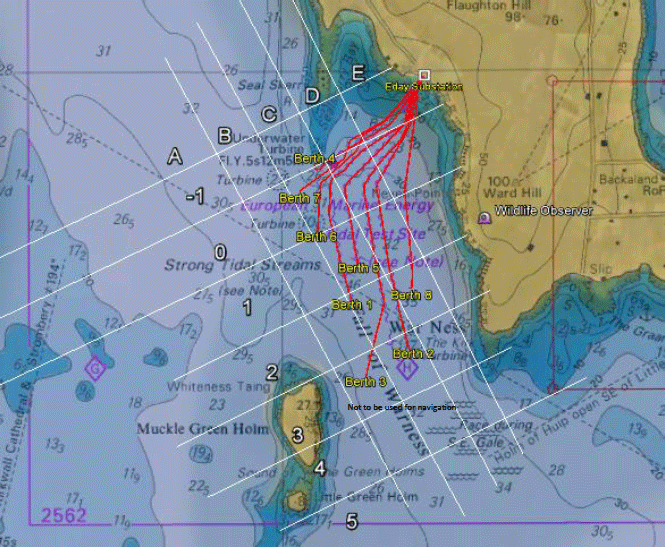Scottish Marine and Freshwater Science Volume 5 Number 7: EMEC Fall of Warness Tidal Test Site: Wildlife Observations Project Annual Report
Annual report of the wildlife observation programme underway at the European Marine Energy Centre (EMEC) in Orkney - Fall of Warness
3. Methodology
In 2005, Highland and Islands Enterprise ( HIE) commissioned local environmental consultants Aurora Environmental Ltd. to produce a survey methodology for marine wildlife observations. These consultants worked with SMRU to set up the wildlife observation project and train the wildlife observers, but no formal documentation was produced. The methodology involved recording numbers, location and behaviour of individual animals for 20 hours per week throughout the year. The observer's instructions were to undertake watches across a variety of wave and tidal states, times of day, and weather conditions, but a formal watch system was not specified. Full details of these variables were recorded along with the species sighting data.
In 2010, EMEC and SMRU Ltd produced documentation to accurately reflect the methodology used at the site to facilitate recording the presence, distribution and behaviour of marine mammals and marine birds. At this point a formal watch rota was introduced in order to ensure a full range of sampling across available watch times. This methodology is available to download from the Marine Scotland Interactive website [2] . The formal methodology with defined scheduling of watches was implemented in April 2011; however the formal scheduling of watches proved to be unsuccessful in terms of watch attainment due to the conditions often experienced at the site. In May 2011 the formal watch rota was relaxed, and whilst the observers do work to a target watch rota, flexibility in the watch times allows for provision of good temporal and tidal coverage in the observations programme.
3.1 Observations
Fully trained observers stationed on Eday carry out the observations through regular scanning of the test site by telescope (Opticron GS 815, set at 20x magnification) for hour long periods from an elevated vantage point to the south of the island. Due to the size of the study area, which extends down and across the Fall of Warness, a vantage point at approximately 50m above sea level with sufficient height to give good visibility across the whole test site area was chosen. In order to aid accurate recording of sightings, the study area was subdivided into grid squares, by overlaying a matrix of squares of approximately 500m 2. Wildlife sightings are identified to species level, and their location on the grid recorded.
Figure 1 below shows the observation grid overlaid on the EMEC test berths and cables.
Figure 1: Observation grid for EMEC's Fall of Warness tidal test site
3.2 Survey Effort
Observations are routinely carried out for 4 hours at a time (a watch). One watch is routinely carried out per day, 5 days per week, resulting in 20 hours of observations per week. On some occasions, two watches may be performed on the same day in order to maintain a high attainment of watches in periods of bad weather. On rare occasions, a watch may be abandoned part-way through due to deterioration in weather conditions. A target watch schedule is created annually in advance, to ensure a spread of watches over times of day and states of tide. The watch schedule is adhered to as far as possible, however attainment of watches in good environmental conditions is a priority.
Watches are carried out throughout the year during daylight hours, covering the period from 04:00hrs to 20:00hrs during summertime, and 09:00hrs to 15:00hrs in winter. It takes approximately 1 hour to complete a single scan of the entire survey area. A total of 909 hours of observations were completed for the period 1 April 2013 to 31 March 2014.
3.3 Data Recording
The observer records wildlife sightings by making regular scans of the study area in a consistent manner and entering the details of any sightings made on paper field forms. This information is later transcribed into a standard Microsoft Excel template. In addition to sighting data, the observer also records effort (date, start/end time), environmental conditions (tide state, meteorological conditions), and details of any shipping observed in the area during the watch. Completed spreadsheets are submitted to EMEC each month.
Sightings are only recorded for any birds or marine mammals sighted in or on the surface of the sea. Details recorded include grid location, numbers, and behavioural details (eg feeding, diving, swimming, stationary). Birds are only recorded as sightings if they are on the water or hovering directly above the surface (within a few metres). Any birds flying higher than this or birds that are clearly transiting through the survey area are not recorded.
Contact
There is a problem
Thanks for your feedback
